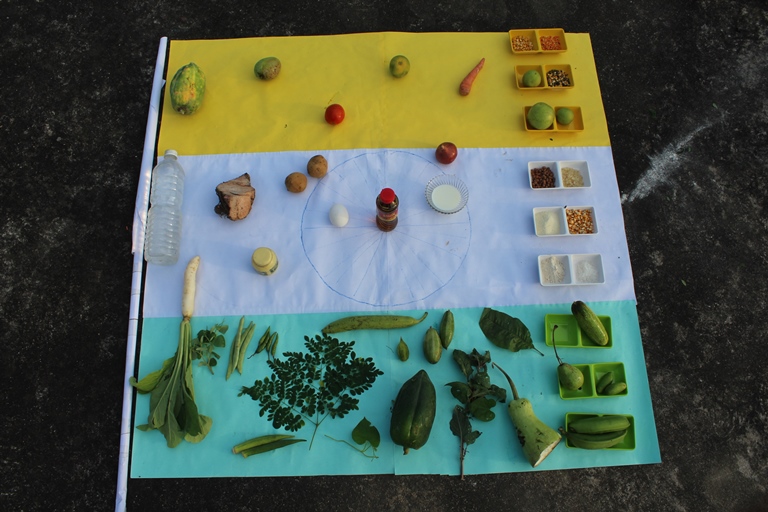Saffron, white and green: In a part of India with some of the country’s highest levels of malnutrition, women are cooking meals made up of those three colors – the colors of the Indian flag – to help improve their families’ diets.
When Indian NGO the Centre for World Solidarity (CWS) conducted a hunger-mapping survey in a block of 50 villages in Deoghar district, Jharkhand state, researchers found that one in five inhabitants were malnourished. Even when villagers were getting enough food to eat, their diets, which consisted mainly of rice and potatoes, weren’t providing the right amount of micronutrients, causing a host of health problems like stunting, anemia and weakened immune systems.
To encourage women to cook balanced meals for their families, volunteers from CWS introduced them to the “tricolor” method – using the country’s tricolor flag to represent the colors of foods that should be present on every plate at every meal. Saffron for lentils or oil; white for rice, milk or eggs; and green for leafy vegetables. To keep the scheme sustainable, the volunteers made sure all of the foods in the meal plan could be sourced locally.
CWS joint director Rajesh Jha spoke with Women & Girls about the challenges – and the payoffs – of upending long-held cooking habits.
Women & Girls: How did your program get started?
Rajesh Jha: When we did our hunger mapping survey five years ago, we saw shocking amounts of malnutrition. About half of the children were malnourished, with more than a third of them severely so. In fact, this was so widespread that malnourished children’s parents often didn’t realize that anything was really wrong – it was just the norm. Women, too, were particularly affected. More than three-quarters of them were anemic.
When we started looking at what people in these villages were eating, we realized that for them, eating the most prevalent local crops – potatoes and rice – at every meal was standard. This carbohydrate-rich diet gave the men and women energy to go do physically demanding wage labor. However, what they didn’t know was that this diet left them with major nutritional deficits.
Ironically, some villagers did grow vegetables in their home gardens, but instead of eating them, they sold them at the market for extra income.
Women & Girls: So what did you then do?
Jha: We partnered with a local organization called Abhivyakti Foundation to address this problem in a variety of ways. This included on-site camps to help the most severely malnourished children gain weight and programs to encourage mothers to breastfeed.
But we also wanted to encourage the villagers to eat more balanced meals, and that’s where the “tricolor” approach came in.
We trained local women and girls, who then put on street plays emphasizing the idea that India is only healthy when it has all three colors in its flag and that people are only healthy when they have all three colors in their meals.
Women & Girls: Was it difficult to get the villagers to change their diets?
Jha: We did meet with some resistance at first, especially from the older women who were set in their ways – they had little knowledge of the health benefits of vegetables, and saw them mainly as a source of income. For one thing, we couldn’t just tell families with modest means to eat their vegetables instead of selling them. And we couldn’t just say, “Grow bigger gardens.” Since most villages don’t have irrigation facilities, they can only grow small gardens.
So, we introduced them to a system of sustainable integrated farming. They planted appropriate seeds at appropriate times to increase their yield. We also promoted multi-tier kitchen gardens. Now, villagers can still sell just as many vegetables on the market, but can also keep their extra vegetables to eat. Even better, some women report that on top of this, they also have more vegetables than before to sell, so they’re adding to their family’s income.
We also found that beliefs sometimes got in the way. For example, in some villages, we noticed that they never planted papaya or banana trees. They believed that if they planted these trees, someone from their family may die. So we planted some banana and papaya trees on some free land. Once they saw that nobody died, they no longer feared planting these trees.

Women & Girls: What results have you seen?
Jha: These days, we estimate that more than 40 percent of women [in the 50 villages] are cooking tricolor meals. Many women who at first saw no need to change their cooking habits were quickly convinced once they gave it a try. In a matter of weeks, they see their kids’ skin clear up and their hair become thicker. They also see sons or daughters who were listless become more talkative and energetic.
Since we started our efforts in these villages, 60 percent of the children we identified as malnourished have been rehabilitated. Of course, it is difficult to measure exactly how much the tricolor program has done to combat malnutrition in relation to our other programs as well as government schemes. But the feedback from the cooks, that is, the mothers – who report that they, too, feel much healthier – is extremely encouraging.
This conversation was edited for length and clarity.
